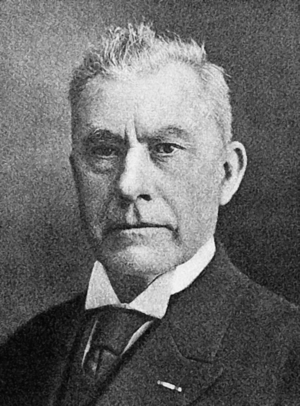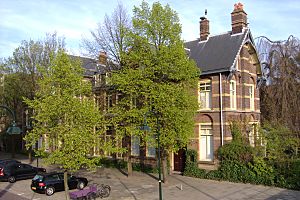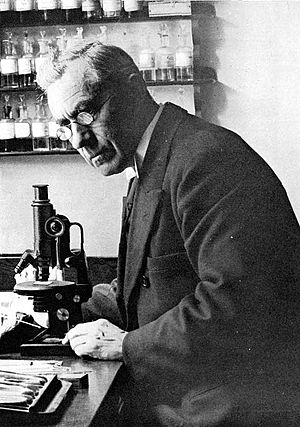Martinus Beijerinck facts for kids
Quick facts for kids
Martinus Beijerinck
|
|
|---|---|
 |
|
| Born | 16 March 1851 Amsterdam, Netherlands
|
| Died | 1 January 1931 (aged 79) Gorssel, Netherlands
|
| Alma mater | Leiden University |
| Known for | One of the founders of virology, environmental microbiology and general microbiology Conceptual discovery of virus (tobacco mosaic virus) Enrichment culture Biological nitrogen fixation Sulfate-reducing bacteria Nitrogen fixing bacteria Azotobacter (Azotobacter chroococcum) Rhizobium Desulfovibrio desulfuricans (Spirillum desulfuricans) |
| Awards | Leeuwenhoek Medal (1905) |
| Scientific career | |
| Fields | Microbiology |
| Institutions | Wageningen University Delft School of Microbiology (founder) |
| Influences | Adolf Mayer |
| Influenced | Sergei Winogradsky |

Martinus Willem Beijerinck (16 March 1851 – 1 January 1931) was a Dutch microbiologist and botanist. He was one of the main scientists who helped start the study of virology (the study of viruses) and environmental microbiology. He is famous for discovering viruses, which he called "contagium vivum fluidum" (contagious living fluid).
Contents
Life and Education
Early Life and Studies
Martinus Beijerinck was born in Amsterdam, Netherlands. He studied at the Technical School of Delft, where he became a chemical engineer in 1872. Later, he earned his Doctor of Science degree from Leiden University in 1877. At that time, the Delft school could not give out doctorates, so Leiden University helped with that.
Beijerinck became a teacher of microbiology at the Agricultural School in Wageningen, which is now Wageningen University. He later taught at the Delft Polytechnic, now known as Delft University of Technology. He also started the Delft School of Microbiology. His work in farming and industrial microbiology led to important discoveries in biology. Unlike other famous scientists of his time, like Robert Koch and Louis Pasteur, Beijerinck did not study human diseases.
In 1877, he wrote an important research paper about plant galls, which are strange growths on plants. This paper later became the basis for his doctoral degree. In 1885, he became a member of the Royal Netherlands Academy of Arts and Sciences.
Scientific Discoveries
Martinus Beijerinck is known as one of the people who started the field of virology. In 1898, he showed that tobacco mosaic disease was caused by something even smaller than a bacterium. This tiny agent could pass through filters that would stop bacteria.
Another scientist, Dmitri Ivanovsky, had seen similar results in 1892. Like Ivanovsky, Beijerinck could not grow this infectious agent outside of living plants. However, he realized that the agent could grow and multiply inside living plants. He named this new pathogen a virus, meaning "poison," to show it was not a bacterium. Beijerinck thought the virus was like a liquid, calling it "contagium vivum fluidum" (contagious living fluid). It wasn't until much later, in the 1930s and 1940s, that scientists proved viruses were tiny particles.
Beijerinck also studied nitrogen fixation. This is a process where nitrogen gas from the air is changed into a form that plants can use. He found that special bacteria living inside the roots of certain plants, like legumes, do this job. This discovery was very important for understanding soil fertility and agriculture. It also showed a great example of symbiosis, which is when different living things help each other.
He also discovered how some bacteria can use sulfate instead of oxygen to breathe. This process is called bacterial sulfate reduction. This discovery helped scientists understand how different chemicals move through the Earth's environment. Beijerinck found the first known sulfate-reducing bacterium, called Desulfovibrio desulfuricans.
Beijerinck also created the enrichment culture method. This is a basic way to study microbes from their natural environments.
Personal Life
Beijerinck was known for being a bit unusual socially. He never married and did not work with many other scientists. He believed that science and marriage did not mix. He loved teaching and sharing his excitement for biology, but he sometimes felt sad because he wasn't very popular with his students. After he retired in 1921, at age 70, he moved to Gorssel and lived there with his two sisters for the rest of his life.
Recognition and Legacy
Several things are named after Martinus Beijerinck to honor his work:
- Beijerinckia, a type of bacteria.
- Beijerinckiaceae, a family of microbes.
- Beijerinck crater, a crater on the Moon.
The M.W. Beijerinck Virology Prize is also awarded in his honor to scientists who make important discoveries in virology.
See also
 In Spanish: Martinus Willem Beijerinck para niños
In Spanish: Martinus Willem Beijerinck para niños
- History of virology
- Nitrification
- Clostridium beijerinckii
- Sergei Winogradsky


